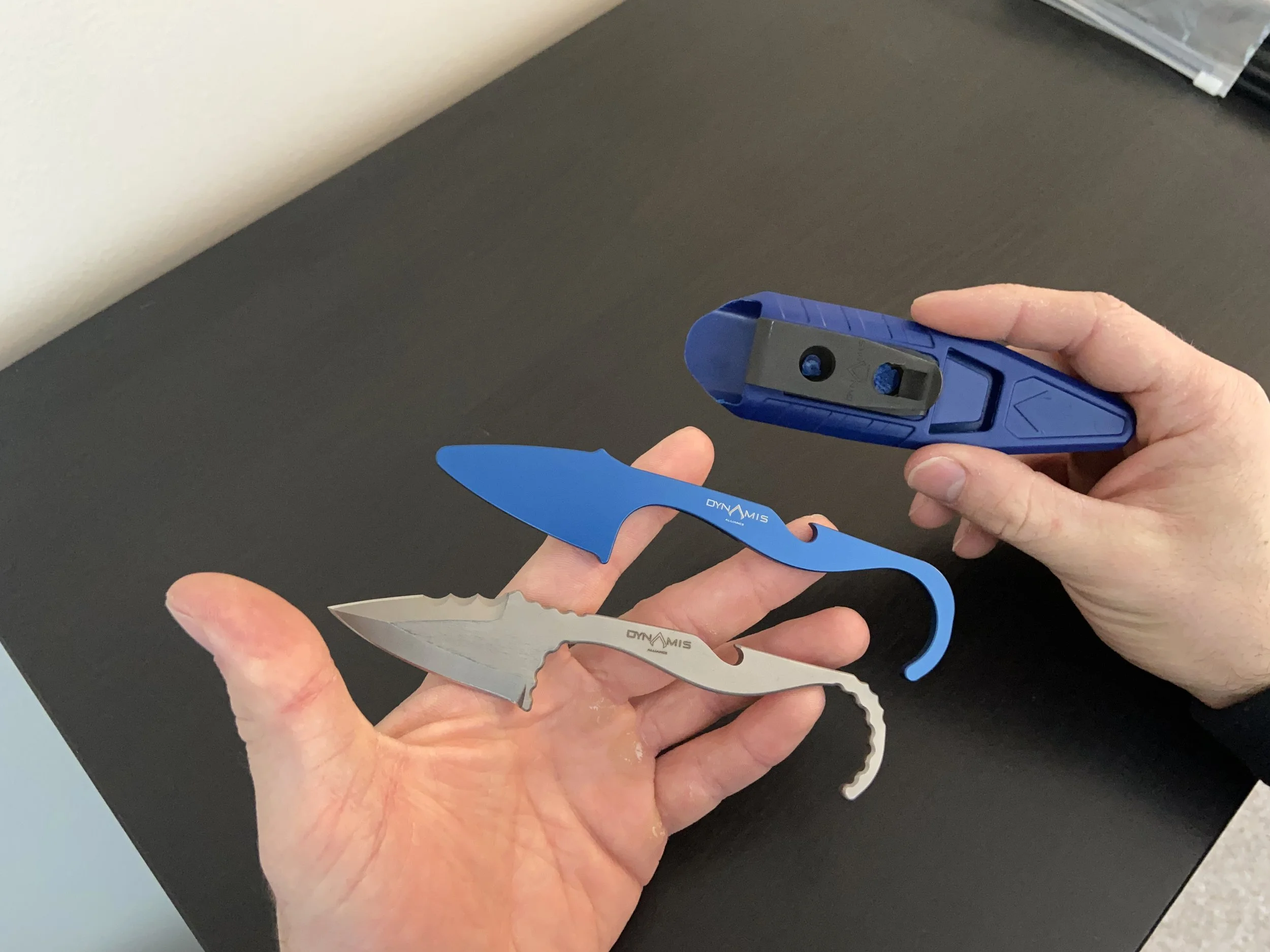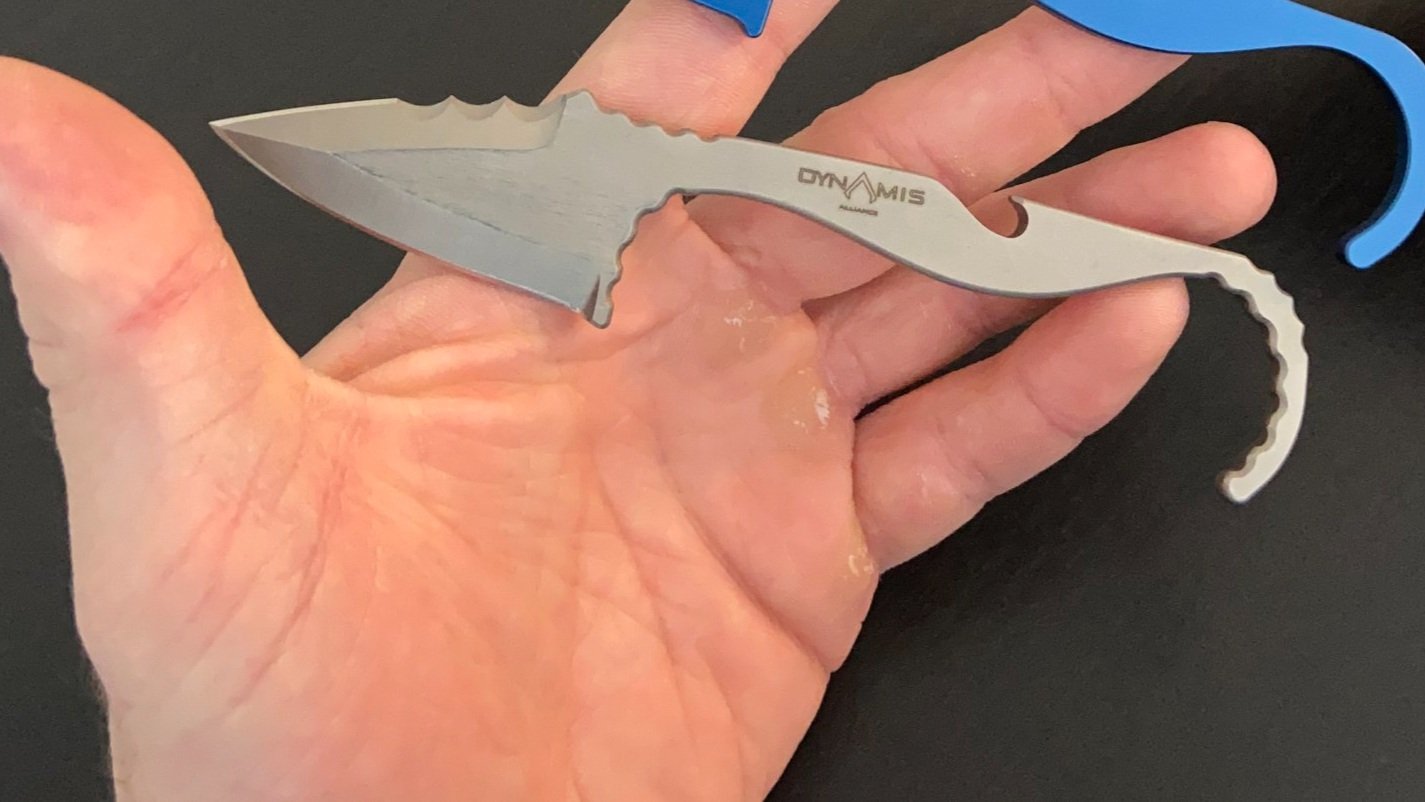Dynamis Alliance SMR Blade Review and Carry Options
Getting Started
The Dynamis Alliance SMR Blade is a small, easily concealable fixed blade geared towards self defense. In the box we get the live blade, a matching trainer, and the sheath. The Blade is double edged with the front side being a straight edge and a serrated edge on the reverse side. The knife is made out of CPMS110V corrosion resistant steel and measures 5.75” in total length with a 2” cutting edge.
What I like
The Blade
Example of a sharpening choil
The length of the handle is really nice, it is big enough to get a full grip on, while still being easy to conceal whether inside or outside the sheath.
The double edged blade means that it can be used in a regular grip or a reverse grip (edge facing your body) in both a point up or a point down orientation - Point down/edge in being what I prefer.
The blade does not have a sharpening choil (divot that separates the cutting edge from the handle), I like this because the sharpening choil tends to be a snag point when trying to stab through clothing.
The hook on the handle allows you to quickly draw it from the sheath, while still allowing it to sit very low in the sheath for easy concealment. I like this much better than something like a ring handled knife, which has many downsides from safety concerns, to not being able to easily switch hands with the knife. I also believe that a ring actually makes the knife harder to draw quickly because you have to be much more accurate getting your finger into the ring to draw, whereas with the hook, you can just close your hand around the handle, and when you begin to pull the knife from the sheath, that hook will catch the top of your hand.
The Trainer
I like that the knife comes with a trainer. I believe that any tool you are planning on using for self defense should have a matching trainer. The trainer is an exact replica of the blade minus any sharp edges or jimping.
You do have to be careful with metal trainers like this one when practicing with another real person. Metal trainers can cause serious injury if used incorrectly. This trainer is mainly good for practicing your draw, using on a dummy, or light sparing with a partner. Something like a foam trainer should be used to live - full force training on another person.
The Sheath
The sheath is injection molded and ambidextrous for use by both right and left handed carriers. I like that the sheath holds both the live and the trainer blade meaning you can get a few reps in before you leave the house, pop the trainer out, put the live blade in, and go about your day.
I like how deep the knife sits in the sheath. This make is extremely concealable.
The sheath ZERO clip is very similar to the Discrete Carry Concepts Clips which are a standard on all of my self defense equipment. The metal clip has a tooth which snags strongly onto clothing, meaning you do not need to clip it over a belt and can still draw the knife without the sheath going anywhere.
I like the zero clip especially for when I’m working out. This allows me to easily clip the knife to my sweatpants or gym shorts.
I also like this feature when I need to dress up in dress pants with a tucked in shirt. The clip is “tuckable” meaning you can run the clip over your pants and behind your belt, then tuck your shirt in behind the clip. This makes for an extremely discrete carry setup.
Things I would change
The Serrated Blade - I do not like serrations on a defensive or fighting knife. Serrations are notorious for getting snagged in clothing. This means you may get one good stab and then your knife is stuck and unusable. Serrations also make it so you cannot “stab and rip”. This technique allows you to increase the damage and effectiveness of your stab when using the knife for self defense purposes. I wish they would have either just made both edges a straight blade, or went with a single, straight edge on the reverse side (facing your body).
The hook “curling over” - I do like the hook on the handle and think that it helps with your draw. I do wish though that is didn’t start behind around into more or a ring shape. This makes it hard to just wrap your hand around the knife and pull. I demonstrate this more in the video above.
Carry Positions
Waist line (vertical)
Carrying in the waist line in a vertical orientation make the knife easy to conceal and draw into a point down grip.
Clipped to front pocket
Carrying the knife clipped to your front pocket may be slightly more comfortable for some people. This carry position allows you to easily draw the blade while remaining somewhat concealed. In this position people will be able to see the clip on your pocket more easily than if it were vertical in your waistline, but it isn’t extremely obvious, especially with the dark color of the clip.
Waist line (horizontal)
This more unconventional carry position is one of my favorites. With the blade riding horizontal, it is hardly noticeable to the wearer even when bending over. The short overall length on the knife allows it to still be easily concealable and you do not get much printing. Why I like this position so much is the ease of the draw and how discretely I can pull it. I do not need to clear my shirt out of the way and need very minimal arm movement. This means I can get the knife out very quickly and discretely by reaching up under my shirt, grabbing the hook, and pulling down, resulting in a point down grip. This position also allows me to draw the knife in scenarios that I wouldn’t be able to if it was carried vertically, such as my arms are being held down.
Conclusion
Overall, this knife wouldn’t be my first option, but I do like it. My favorite part of the knife is the small size, ease of concealability, and multiple carry options. The serrations on the blade are really the deal-breaker for me. By testing knives and training on an organic medium covered in clothing, you will quickly see the downsides of serrations on a blade.
If you like this content and would like to see more, please check us out on our social media pages linked below. If you are interested in training, take a look at our training page or reach out!







